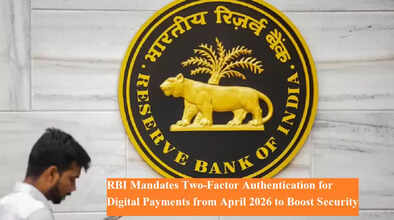RBI Mandates Two-Factor Authentication for Digital Payments from April 2026 to Boost Security

The Reserve Bank of India (RBI) has announced a major regulatory move aimed at strengthening the safety of digital transactions across the country. Starting April 1, 2026, all digital payments in India will require mandatory two-factor authentication (2FA), ensuring an extra layer of protection against online frauds.
A Stronger Shield Against Online Threats
Digital payments have become the backbone of India’s financial ecosystem, but with this rapid expansion comes a surge in cybercrimes such as phishing, SIM swapping, and identity theft. To address these challenges, the RBI has introduced a new rule that obligates payment service providers to use at least two independent methods of verification before approving any transaction.
Under the upcoming framework, customers will have to authenticate payments using a combination of methods such as:
-
Passwords or PINs
-
One-Time Passwords (OTPs)
-
Biometric identification (fingerprint or facial recognition)
-
Hardware tokens
-
Device-native authentication features
By diversifying verification methods, RBI aims to minimize dependence on SMS-based OTPs, which are currently the most common but also the most vulnerable to hacking attempts.
Dynamic Authentication for Every Transaction
One of the key highlights of this regulation is the requirement of at least one dynamic factor of authentication. This means that for every transaction, at least one verification method must be unique and valid only for that particular payment attempt. For example, an OTP or biometric scan specific to the transaction will be mandatory to confirm the user’s identity.
This dynamic approach makes it significantly harder for fraudsters to reuse stolen credentials or intercept payment details.
Liability and Customer Protection
The RBI has also made it clear that the liability for authentication failures will rest with payment providers and banks, not the customers. If any fraudulent transaction occurs due to negligence in following authentication protocols, customers will be entitled to full compensation.
This customer-first approach is expected to boost trust in digital payments and encourage more people to adopt cashless transactions without fear of financial loss.
Risk-Based Authentication for Enhanced Safety
In addition to mandatory 2FA, RBI’s new framework allows banks and fintech companies to introduce risk-based authentication checks. This system will analyze user behavior, device information, transaction history, and geolocation to detect unusual activity. If a payment attempt appears suspicious, additional verification steps will be triggered before approval.
For instance, if a user typically transacts from Delhi but suddenly attempts a high-value transfer from another country, the system may demand biometric confirmation or an extra OTP. This layered security will add further resilience to India’s digital payments infrastructure.
A Step Towards a Safer Digital Economy
India is one of the fastest-growing digital payment markets in the world, with UPI (Unified Payments Interface) transactions crossing record highs every month. However, the rise in usage has also made the ecosystem a prime target for cybercriminals. The RBI’s upcoming rule is seen as a proactive move to balance convenience with robust security.
Cybersecurity experts have welcomed the regulation, noting that it aligns India with global best practices in digital payment security. Many developed countries already enforce mandatory multi-factor authentication to safeguard online banking and transactions.
What It Means for Consumers and Businesses
For consumers, the change means greater peace of mind while making payments online or via mobile apps. Although it may add one extra step to the payment process, the enhanced safety is expected to outweigh the minor inconvenience.
For businesses, especially fintech firms, the new regulation will require significant updates in technology infrastructure. They will need to integrate biometric systems, tokenization, and advanced fraud detection mechanisms to comply with RBI’s rules before the April 2026 deadline.
Conclusion
The RBI’s decision to make two-factor authentication compulsory for all digital payments marks a turning point in India’s financial security landscape. By reducing reliance on vulnerable OTP systems and introducing dynamic, multi-layered checks, the central bank aims to protect millions of digital payment users from fraud.
With customer liability capped and payment providers bearing responsibility for security lapses, this regulation could pave the way for a safer, more reliable, and user-friendly digital payment ecosystem in India.

